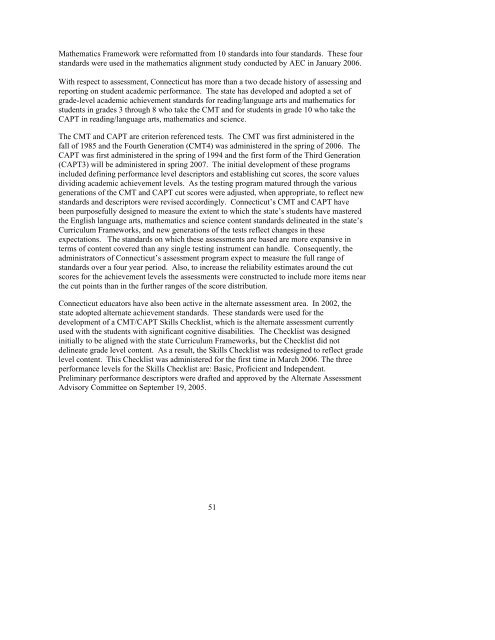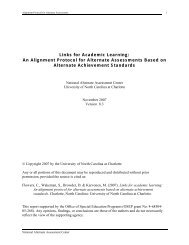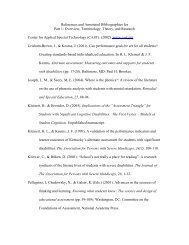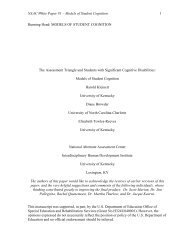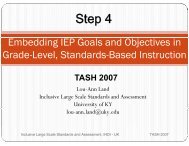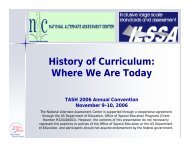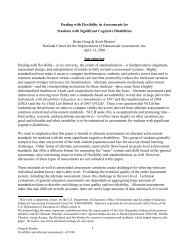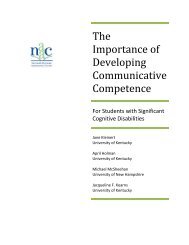CMT-CAPT Skills Checklist Technical Manual. - NAAC
CMT-CAPT Skills Checklist Technical Manual. - NAAC
CMT-CAPT Skills Checklist Technical Manual. - NAAC
You also want an ePaper? Increase the reach of your titles
YUMPU automatically turns print PDFs into web optimized ePapers that Google loves.
Mathematics Framework were reformatted from 10 standards into four standards. These fourstandards were used in the mathematics alignment study conducted by AEC in January 2006.With respect to assessment, Connecticut has more than a two decade history of assessing andreporting on student academic performance. The state has developed and adopted a set ofgrade-level academic achievement standards for reading/language arts and mathematics forstudents in grades 3 through 8 who take the <strong>CMT</strong> and for students in grade 10 who take the<strong>CAPT</strong> in reading/language arts, mathematics and science.The <strong>CMT</strong> and <strong>CAPT</strong> are criterion referenced tests. The <strong>CMT</strong> was first administered in thefall of 1985 and the Fourth Generation (<strong>CMT</strong>4) was administered in the spring of 2006. The<strong>CAPT</strong> was first administered in the spring of 1994 and the first form of the Third Generation(<strong>CAPT</strong>3) will be administered in spring 2007. The initial development of these programsincluded defining performance level descriptors and establishing cut scores, the score valuesdividing academic achievement levels. As the testing program matured through the variousgenerations of the <strong>CMT</strong> and <strong>CAPT</strong> cut scores were adjusted, when appropriate, to reflect newstandards and descriptors were revised accordingly. Connecticut’s <strong>CMT</strong> and <strong>CAPT</strong> havebeen purposefully designed to measure the extent to which the state’s students have masteredthe English language arts, mathematics and science content standards delineated in the state’sCurriculum Frameworks, and new generations of the tests reflect changes in theseexpectations. The standards on which these assessments are based are more expansive interms of content covered than any single testing instrument can handle. Consequently, theadministrators of Connecticut’s assessment program expect to measure the full range ofstandards over a four year period. Also, to increase the reliability estimates around the cutscores for the achievement levels the assessments were constructed to include more items nearthe cut points than in the further ranges of the score distribution.Connecticut educators have also been active in the alternate assessment area. In 2002, thestate adopted alternate achievement standards. These standards were used for thedevelopment of a <strong>CMT</strong>/<strong>CAPT</strong> <strong>Skills</strong> <strong>Checklist</strong>, which is the alternate assessment currentlyused with the students with significant cognitive disabilities. The <strong>Checklist</strong> was designedinitially to be aligned with the state Curriculum Frameworks, but the <strong>Checklist</strong> did notdelineate grade level content. As a result, the <strong>Skills</strong> <strong>Checklist</strong> was redesigned to reflect gradelevel content. This <strong>Checklist</strong> was administered for the first time in March 2006. The threeperformance levels for the <strong>Skills</strong> <strong>Checklist</strong> are: Basic, Proficient and Independent.Preliminary performance descriptors were drafted and approved by the Alternate AssessmentAdvisory Committee on September 19, 2005.51


